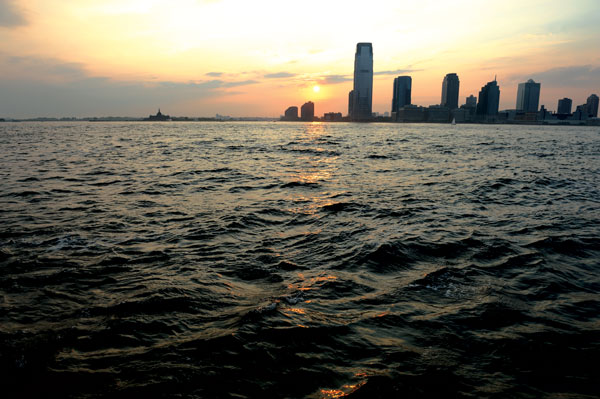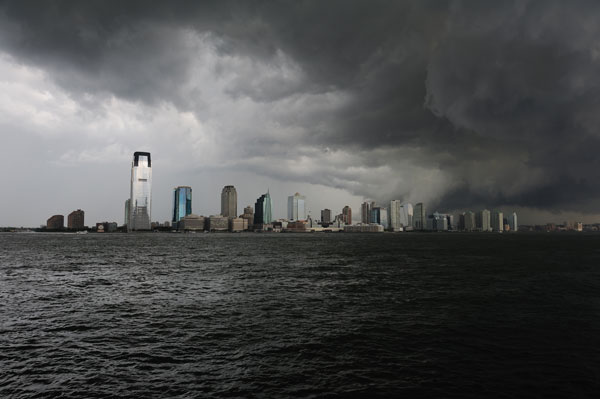Stony Brook, NY, January 27, 2012 - "A Tide Of Concern is Rising Over Risk of Storm Surges," a story that appeared in
The Villager, a weekly newspaper serving downtown Manhattan, late last month, focuses on concerns about sea level rise in and around New York City.

A view in August across the Hudson River to Jersey City from Lower Manhattan. Water levels have already risen due to climate change, according to experts.
Photo by Terese Loeb Kreuzer, The Villager
As pointed out in the article, which features insights by Stony Brook University Oceanography professor and storm surge expert Malcolm Bowman, much of the metropolitan area lies just a few feet above sea level and millions of people live close to New York City’s 520 miles of coastline.
"2-3 million people in the outer boroughs of southern Brooklyn and Queens are at risk, with little chance for escape," says Bowman. "During Hurricane Irene last summer, both buses and subways were shut down well before the hurricane made landfall. So how are these people going to evacuate? Walk? Ever tried walking across Brooklyn? High ground is hard to find and a long way from the coast. It's very flat. If the surge makes it over the beaches, look out; it will spread rapidly through the outer boroughs. People are going to try to squash into the upper floors of tenement buildings and get crushed. What about the infants, children and elderly?"
Bowman, located at
SBU's School of Marine & Atmospheric Sciences, is also a member of
The Stony Brook Storm Surge Research Group, which has been funded principally by New York Sea Grant (NYSG) since 2002 to work on storm surge science, coastal defense systems and policy issues related to regional protection of New York City and Long Island.
According to the Research Group, the New York Metropolitan region is vulnerable to coastal flooding and large-scale damage to city infrastructure from hurricanes and nor'easters. Much of this region - an area of about 100 square miles - lies less than three meters above mean sea level. Within this area lies critical infrastructure such as hospitals, airports, railroad and subway station entrances, highways, water treatment outfalls and combined sewer outfalls at or near sea level.

Storm clouds over New Jersey heading toward Lower Manhattan in August. Two weeks later, Tropical Storm Irene — which had weakened from a hurricane — hit New York.
Photo by Terese Loeb Kreuzer, The Villager
There are three conceivable approaches to dealing with the threat of rising sea levels, said Bowman in the article: (1) The government could decide to do nothing because of lack of sufficient political will or funds; (2) it could fix problems on a case-by-case basis as they arise; or (3) it could take a regional approach.
Bowman noted that “the Dutch have been busily reclaiming and protecting their lowlands for centuries by creating an intricate network of dikes surrounding low-lying tracts of land.” He said that Amsterdam, the capital of the Netherlands, with more than one million residents, in some places, is built on land as much as 8 feet below mean sea level. The Dutch, he stated, “have a highly professional and established engineering, marine hydraulics and governmental infrastructure dedicated to building, maintaining and improving the country’s coastal defenses against the sea. New York should do the same. The city should underwrite feasibility studies by engineering firms, city planners, environmental and community groups to investigate what will work and what will not.”
For more on Bowman's discussions on storm surge-related issues in New York City, see the links in the "Related Info" box on this page.
And for more on this project, search
NYSG's Research Database - You can best find it by searching by Institution (Stony Brook University), Investigator (Dr. Malcolm J. Bowman).
New York Sea Grant (NYSG), a statewide network of integrated research, education, and extension services promoting the coastal economic vitality, environmental sustainability and citizen awareness about the State’s marine and Great Lakes resources, has been “Bringing Science to the Shore” for over 40 years. NYSG, one of 32 university-based programs under the National Sea Grant College Program of the National Oceanic and Atmospheric Administration (NOAA), is a cooperative program of the State University of New York and Cornell University. The National Sea Grant College Program engages this network of the nation’s top universities in conducting scientific research, education, training, and extension projects designed to foster science-based decisions about the use and conservation of our aquatic resources.